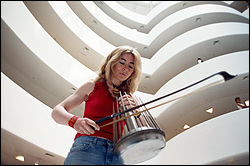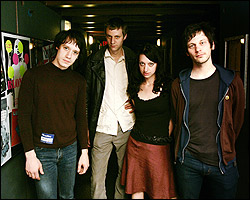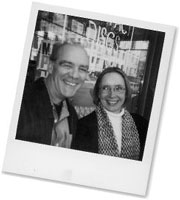You’re 20 minutes into this nuanced and relatively slow-moving documentary before it’s made clear that percussionist Evelyn Glennie is more or less deaf. Director Thomas Riedelsheimer wants you to see her in action—nudging and banging precise rhythms during a public performance on a single snare at Grand Central Station; setting up a recording space inside a loft in Cologne with noted improv artist Fred Frith—before he allows her to tell you that she started losing her hearing at age 8. Riedelsheimer, who previously profiled Andy Goldsworthy in Rivers & Tides, is intent on presenting Glennie first as an artist, second as a deaf artist. But it is the absence of sound (as we typically know it) that makes Glennie the kind of artist that she is.
From Scotland, Glennie has built an international career around her solo drumming work, often in collaboration with other musicians as she travels the world. Footage of these collaborations makes up most of Touch the Sound. Watching Glennie work with other artists (unscripted and often using found objects instead of traditional instruments), her skill and aural vision are amplified. “My whole life is about sound,” she says, referring to those vibrations and wavelengths we generally don’t apprehend. Is this sixth sense—sharpened by the loss of one of the other five—a real phenomenon? Glennie’s fluid, dynamic responses to her musical partners would seem to prove it.
Touch also employs a great deal of silence and empty space to illustrate this point. Images of vividly colored flags flapping in the wind and the quiet sound of metal zipper pulls clicking against their tracks show how it’s possible to see the pattern of such quiet, inconspicuous sounds. Contrasted with Glennie’s music—often loud and pounding but always subtle and complex as well—the idea that sound is everywhere (not just in our ears) is stretched and cemented. (NR)








